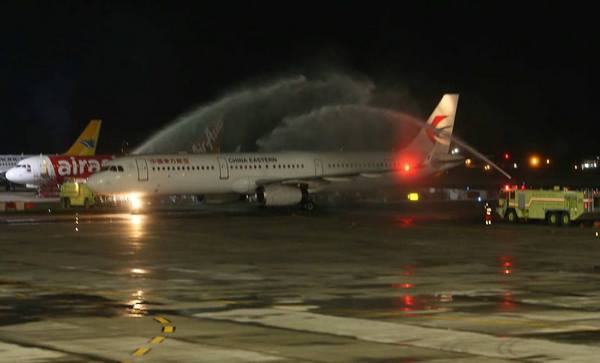Cebu airport, airlines gear up for expected Sino tourist surge

With local and international airlines opening more flight routes to and from different parts of mainland China as shown in this July 31 photo, Cebu will be expecting more Chinese tourists in the coming months. CDN PHOTO/LITO TECSON
Tourism stakeholders in Cebu are preparing for the expected influx of Chinese tourists in the next few months especially since there are more flights to China and from different parts of China to Cebu, and the biggest holidays in China will also be happening in October.
GMR-Megawide Cebu Airport Corp. (GMCAC), the private operator of the Mactan Cebu International Airport (MCIA) terminals, has implemented measures to make it easier for tourists especially the Chinese when they would arrive in Cebu.
These include the installation of way-finding and informational signages in both Terminal 1 and Terminal 2 with Mandarin translations aside from Hangul and Nihongo translations.
This is to ensure that airport processes and directions are well understood not just by Chinese tourists but also by the Korean and Japanese.
“We are mindful of the fact that our traffic growth in Cebu will be driven to a greater extent by our visitors from China. As such, we have taken various initiatives to prepare for this growth,” said GMCAC President Louie Ferrer.
Ferrer said that they had also partnered with the Department of Tourism (DOT) in producing “how to” videos which had detailed the airport processes and that would be aside from the marketing videos about Cebu as a destination that they had produced.
The videos are being promoted through the MCIA’s social media accounts in WeChat which is the top messaging and social media app in China, as well as Facebook.
Golden Week
According to the Chinese Consulate in Cebu, one of the biggest holidays in the People’s Republic of China is the Golden Week, which is a semi-annual, seven-day national holiday which begins on October 1 and ends on October 7.
During this week, employees and students have no work and classes and would often go on vacations abroad like in Cebu which has become popular among the Chinese for its beaches.
Another long holiday for the Chinese is their Spring Festival. It lasts for 23 days and falls usually on January or February.
Ready destinations
According to Cebu Association of Tour Operation Specialists (CATOS) President Alice Queblatin, operators and management of different tourist spots in Cebu should focus on readying their destinations for the influx of Chinese tourists.
She said that as much as local tour operators want to capture the Chinese market, it has been hard for them since language is a major challenge – Cebu does not have enough tour guides that can speak Mandarin.
“So these Chinese tourists bring their own guides. Their itineraries are very basic. What’s important is to make the destinations and activities ready for them,” she told CDN.
A distinct characteristic of Chinese tourists is that they always come in busloads and not as individual travelers, mainly due to the language issue.
This is why, Queblatin said tourism destinations should be able to properly accommodate huge groups of Chinese tourists.
Among the most popular tourist spot for the Chinese, according to Queblatin, is the whale shark watching in Oslob.
For some local players, she said they have also been able to prepare for the coming Chinese tourists like some transportation companies have already bought more buses to accommodate the Chinese.
Airlines
Aside from the preprations, airlines are also taking advantage of this peak season for Chinese tourists by increasing the frequency of their flights from mainland China to Cebu and vice versa.
Starting Sept. 1, Philippine Airlines (PAL) will double its Cebu-Beijing operations, currently served twice week, until Oct. 27 using an Airbus A321 aircraft.
Last month, local and foreign carriers also launched a number of additional flights to China.
This includd China Eastern, which launched its Cebu-Chengdu and Cebu-Nanjing flights last July 2 and July 25, respectively.
Cebu Pacific also started its twice a week chartered flights to Beijing last July 16.
Disclaimer: The comments uploaded on this site do not necessarily represent or reflect the views of management and owner of Cebudailynews. We reserve the right to exclude comments that we deem to be inconsistent with our editorial standards.
